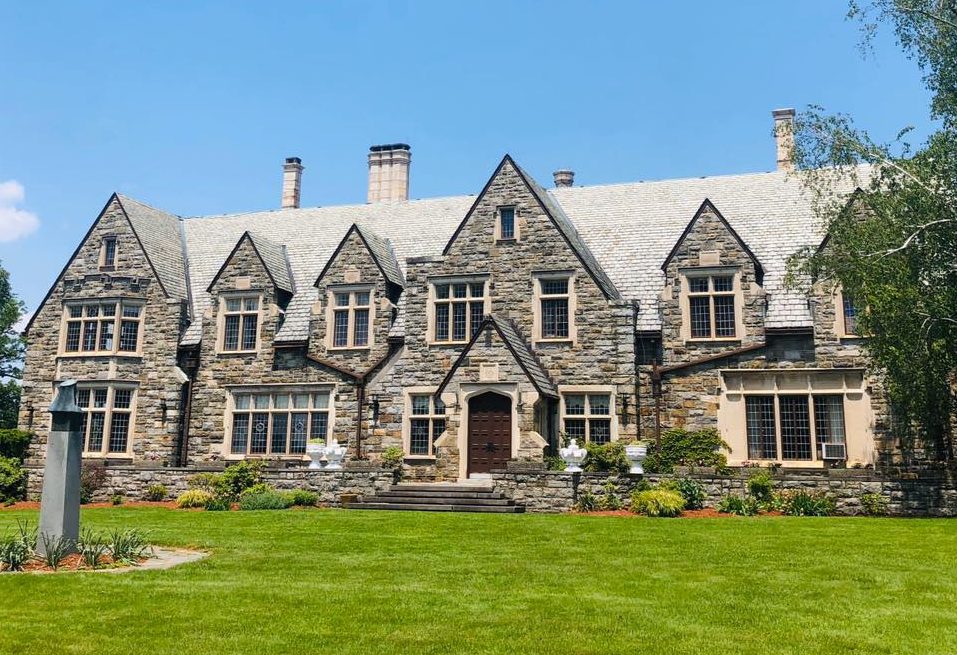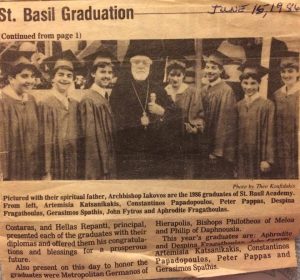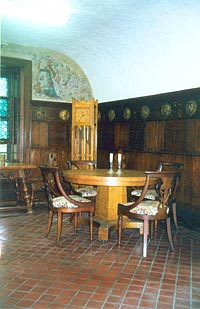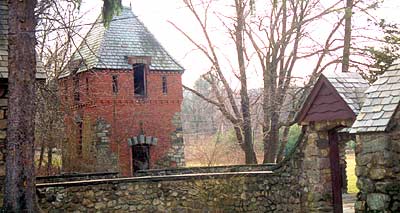Daughters of Penelope raise funds for new plumbing for the Academy

 Archbishop Athenagoras, of Blessed Memory, founded Saint Basil Academy in 1944 with the valuable assistance of the Greek Orthodox Ladies Philoptochos Society. On March 15, 1944, the Philoptochos purchased the 400-acre Jacob Ruppert estate in Garrison New York, on the shores of the Hudson River, overlooking West Point Academy for only $55,000. It was an era when many large estates were put on the market because of the ever-increasing property taxes. In 1976, a parcel of land encompassing 250 acres (primarily marshland) was sold to the Audobon Society.
Archbishop Athenagoras, of Blessed Memory, founded Saint Basil Academy in 1944 with the valuable assistance of the Greek Orthodox Ladies Philoptochos Society. On March 15, 1944, the Philoptochos purchased the 400-acre Jacob Ruppert estate in Garrison New York, on the shores of the Hudson River, overlooking West Point Academy for only $55,000. It was an era when many large estates were put on the market because of the ever-increasing property taxes. In 1976, a parcel of land encompassing 250 acres (primarily marshland) was sold to the Audobon Society.
The Archbishop dreamed of establishing an orphanage or children’s home ever since his arrival in the United States in 1931. The Philoptochos purchased the Ruppert estate with the proceeds of two years of the Vasilopita celebrations. The Academy, as envisioned by the late Patriarch Athenagoras, has expanded in scope to be a well equipped Residential Child Care Center, with modern dormitories, a gymnasium/auditorium, indoor swimming pool, beautiful chapel, library and all the necessary comforts of a loving home.
The Academy was named for Saint Basil, who was the founder of many orphanages, hospitals, and homes for the elderly in fourth century Caesarea, Asia Minor. He is considered one of the greatest philanthropists of the Church and founder of the modern-day hospital concept.

 On January 30, 1919, Colonel Jacob Ruppert purchased the estate. Mr. Ruppert subsequently added to his land holdings the acquisition of a section of land between the old Route 9D which bordered the estate and the new Route 9D which was moved east. This portion was part of the E.R. Dick property and was conveyed by Gilbert Forman on July 9, 1935. A large tract of marshland adjacent to the Astoria Silk Works, the Plumbish Farms and east of Constitution Island was purchased by Jacob Ruppert on January 29, 1926 from James Kirke Paulding and was sold to the Audobon Society in 1976 by the Academy.
On January 30, 1919, Colonel Jacob Ruppert purchased the estate. Mr. Ruppert subsequently added to his land holdings the acquisition of a section of land between the old Route 9D which bordered the estate and the new Route 9D which was moved east. This portion was part of the E.R. Dick property and was conveyed by Gilbert Forman on July 9, 1935. A large tract of marshland adjacent to the Astoria Silk Works, the Plumbish Farms and east of Constitution Island was purchased by Jacob Ruppert on January 29, 1926 from James Kirke Paulding and was sold to the Audobon Society in 1976 by the Academy.
 At “Eagle’s Rest”, he had one of the largest collections of small monkeys, wild birds, and peacocks, in the world. There too, he had a fine collection of furniture, pottery, jade and Chinese porcelains. From his purchase of the estate in 1919, until his death in 1939, he transformed the grounds into a magnificent showplace. Employing over 40 people, over 26 buildings were added and in 1929, he replaced the Fitzgerald’s Victorian clapboard mansion with a cut granite Tudor manor with over 40 rooms. The rooms of the first floor he adorned with fireplaces, wood paneling and brass chandeliers all imported from Western Europe. The southern portion of the estate contained his farm and zoo. On the grounds, he created a piece of the English countryside, with stonewalls, slate roofs, decorative wells, gazebos, landscaped paths and aviaries. The estate was the site of numerous parties. Members of the New York Yankees and his brewery friends often stayed as overnight guests.
At “Eagle’s Rest”, he had one of the largest collections of small monkeys, wild birds, and peacocks, in the world. There too, he had a fine collection of furniture, pottery, jade and Chinese porcelains. From his purchase of the estate in 1919, until his death in 1939, he transformed the grounds into a magnificent showplace. Employing over 40 people, over 26 buildings were added and in 1929, he replaced the Fitzgerald’s Victorian clapboard mansion with a cut granite Tudor manor with over 40 rooms. The rooms of the first floor he adorned with fireplaces, wood paneling and brass chandeliers all imported from Western Europe. The southern portion of the estate contained his farm and zoo. On the grounds, he created a piece of the English countryside, with stonewalls, slate roofs, decorative wells, gazebos, landscaped paths and aviaries. The estate was the site of numerous parties. Members of the New York Yankees and his brewery friends often stayed as overnight guests.